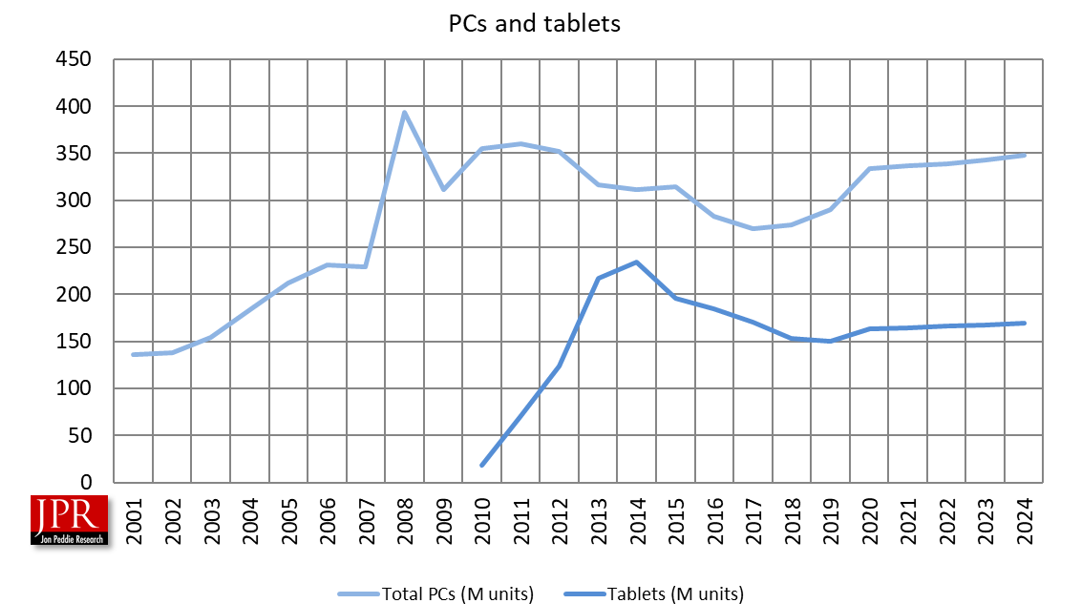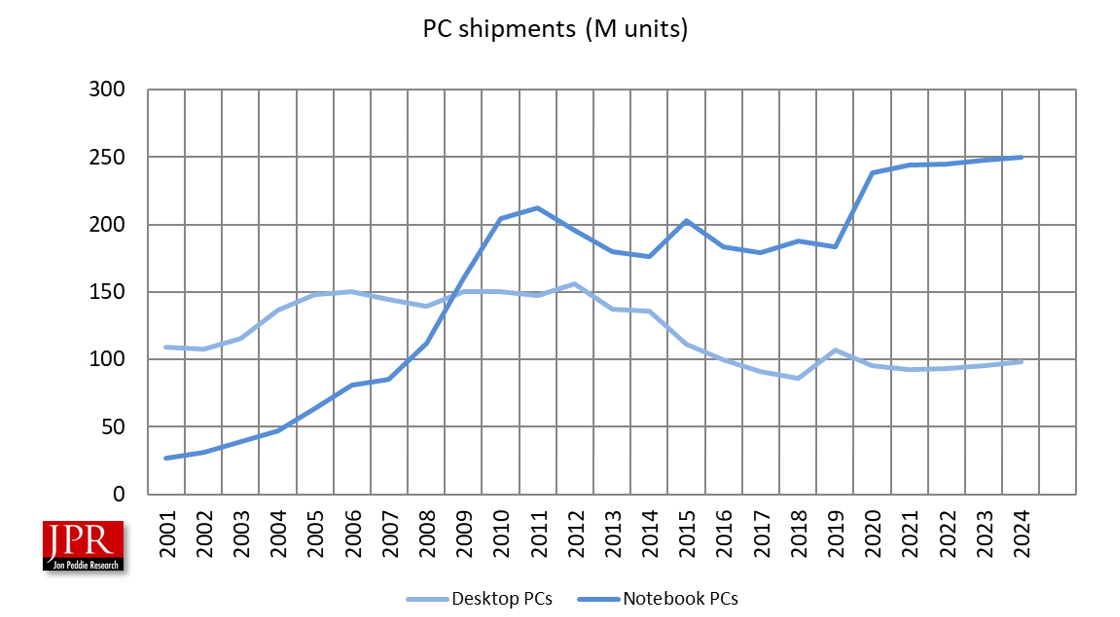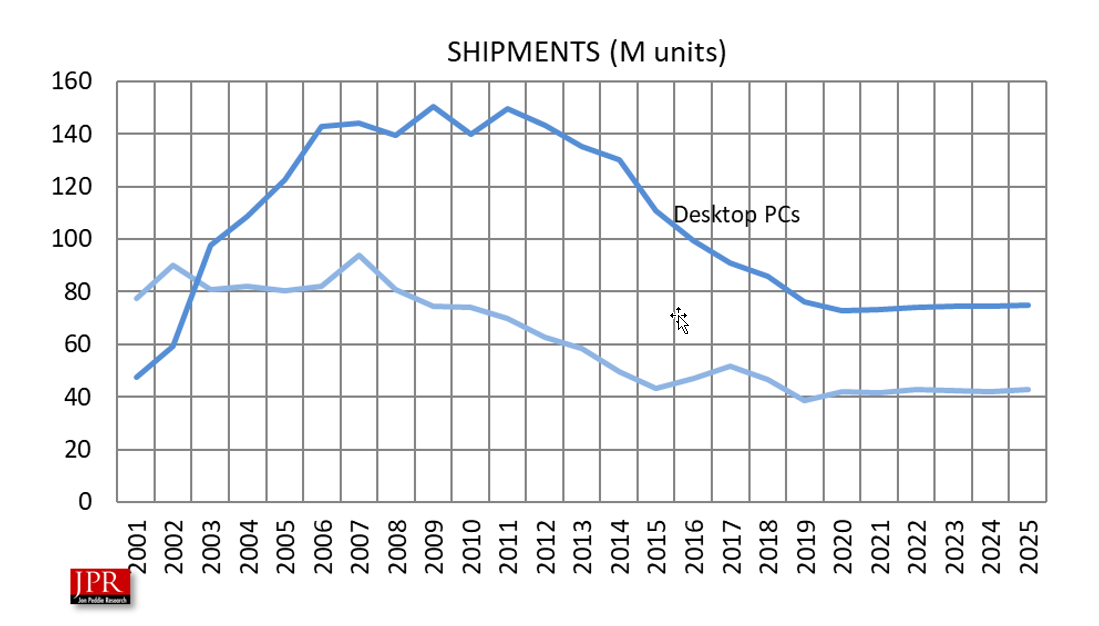The PC industry has been on a rollercoaster ride for the past decade or longer: up, down, up, down, up. In 2010, when Paul Otellini was Intel’s CEO, he forecast robust growth for the PC (and Intel) over the next ten years, and spoke about the next billion units. At the time, the installed base of PCs was a billion units, and Otellini thought they could double that in ten years or less.

But it was rear-view mirror forecasting, and Intel (and quite a few others, including the tablet builders) didn’t anticipate the tablet’s popularity. It changed the momentum of the PC and put it into a seven-year decline. Many people forecast the end of the PC. We’d all work on just our smartphones and tablets. RIP PC. But those sharpshooters didn’t (and still don’t) understand the nature or history of the PC.
 Shipments and forecast growth of PCs and tablets
Shipments and forecast growth of PCs and tablets
Before the tablet, many people, maybe 100 million-plus, were using a PC for trivial —things like email, recipes, maybe some light-weight photo editing, music, etc. The tablet freed them and their wallets. Anxious to get off the upgrade and replacement cycle thrust on them by Microsoft, they flocked to the tablet. It was, and is, lightweight, totally mobile, has a big enough screen, is cheap (relative to PCs of the time), and didn’t need to be replaced every other year.
That was, is, history.
The PC didn’t go away, but two important factors emerged about the PC that took some time for the suppliers to understand.
- People were still buying PCs and accessories like Add-in-Boards (AIBs), just not as frequently. The payoff just wasn’t there to upgrade every two or three years, and five years became the average replacement cycle.
- Users, including some tablet enthusiasts (re)discovered the PC is an essential tool, and there are things you can only do on and with a PC.
And then the pandemic hit.
When we were all sent home to work, it caused an incredible churn and disruption in behavior and productivity—mainly for the better. People and companies discovered the workers at home were more productive. Getting out of their cars, trains, and airplanes gave them more productive time, and a whole lot of less stress. The environment liked it too.
But working at home meant you had to have something to work on and with. Lots of people had laptops, and many had home PCs. Some folks took their office PC or workstation home when allowed. But a whole lot of people discovered their home PC, which was actually the household PC wasn’t up to snuff or was in use by multiple people. That resulted in a PC buying run, and soon everything was sold out.
 Shipments of notes and desktops
Shipments of notes and desktops
Production, however, was slowed to stopped due to go-home rules. So demand built, and backlogs grew. We’re still working our way out of that and will probably be caught up by Q4. Maybe. The disruption upset the supply chain and drove up prices. In the second half, parts, like memory chips, are going to increase in cost.
Workers won’t be the only ones sent home, so were all the kids. No school today, and it’s not even snowing.
But the schools and kids quickly came to the same realization as the workers—no PCs, no school. That created the great Chromebook rush of 2020, and school systems emptied out their capital equipment funds for a year in one quarter. And since Chromebooks get counted as PCs (because most of them are powered by an X86), the number of PCs shipped went up—margins not so much.
And now we’re getting control of the pandemic. Will we go back to how it was? Will we make people drain their morale sitting in front of a polluting machine for a couple of hours a day? We will send the kids back to school and dump them and their problems on the underpaid and under-appreciated teachers. Will we need more Chromebooks after that? Probably, kids are hard on machines, and once Pandora’s Box is opened, those computers aren’t going back in the box.
Where’s the Money?
But, if more Chromebooks are needed for kids, where’s the money going to come from? Schools have been traditionally investment starved for decades.
Many companies that bought new gear for the workers at home now have a swollen CapEx inventory. That’s going to have to be written down. It’s not likely the purchasing will be so strong in the second half
So the new normal is some kids, hopefully the underprivileged, will get new or at least used Chromebooks, and we’ll narrow (not close, but narrow) the digital divide. Many people will continue to work at home and go to the office only occasionally. That will help reduce pollution, lessen the need for constructing new buildings, and mitigate the load on the ones already leased.
Cryptic crypto.
In 2017, when the value of crypto coins relative to U.S. dollars (because the crypto coins have no intrinsic value of their own) soared, one coin, Ethereum, rose almost as rapidly as the bellwether Bitcoin. It turns out that Ethereum hash mining exploits the GPU-memory interface making GPUs ideal Etherum mining tools. AIB sales skyrocketed and fell just fast in late 2018.
A similar run up took place in the second half of 2020 and has carried on into the first half of 2021. The result was scalpers hoarding AIBs in anticipation of miners’ willingness to pay anything to get them. The secondary effect was AIBs were priced out of reach of the loyal gamers who support and move the AIB market.
The good news of the pandemic, if it’s possible to ignore all the people who died and are yet to die, is that we as an industry, maybe people, have learned we don’t have to do things the way we always did just because that’s the way we always did it. We can improve the quality of life and general morale and get our most valuable asset—our smart workers, out of their cars, out of mind-numbing wasteful meetings, and let them do what they really want to do—create things. And to do that, they are going to need good tools.
RIP PC, long live the PC. (JP)
This article was originally published in Jon Peddie’s excellent TechWatch report and is reproduced with kind permission.
Dr. Jon Peddie is a recognized pioneer in the graphics industry, President of Jon Peddie Research and named one of the most influential analysts in the world. He lectures at numerous conferences and universities on topics pertaining to graphics technology and the emerging trends in digital media technology. Former President of Siggraph Pioneers, he serves on advisory board of several conferences, organizations, and companies, and contributes articles to numerous publications. In 2015, he was given the Life Time Achievement award from the CAAD society Peddie has published hundreds of papers, to date; and authored and contributed to eleven books.
His most recent tech title was “Augmented Reality, where we all will live.” His latest fiction work, Database, is here (please feel free to upvote it!!)
(and his next one will be on some key technology history!) Jon has been elected to the ACM Distinguished Speakers program.


